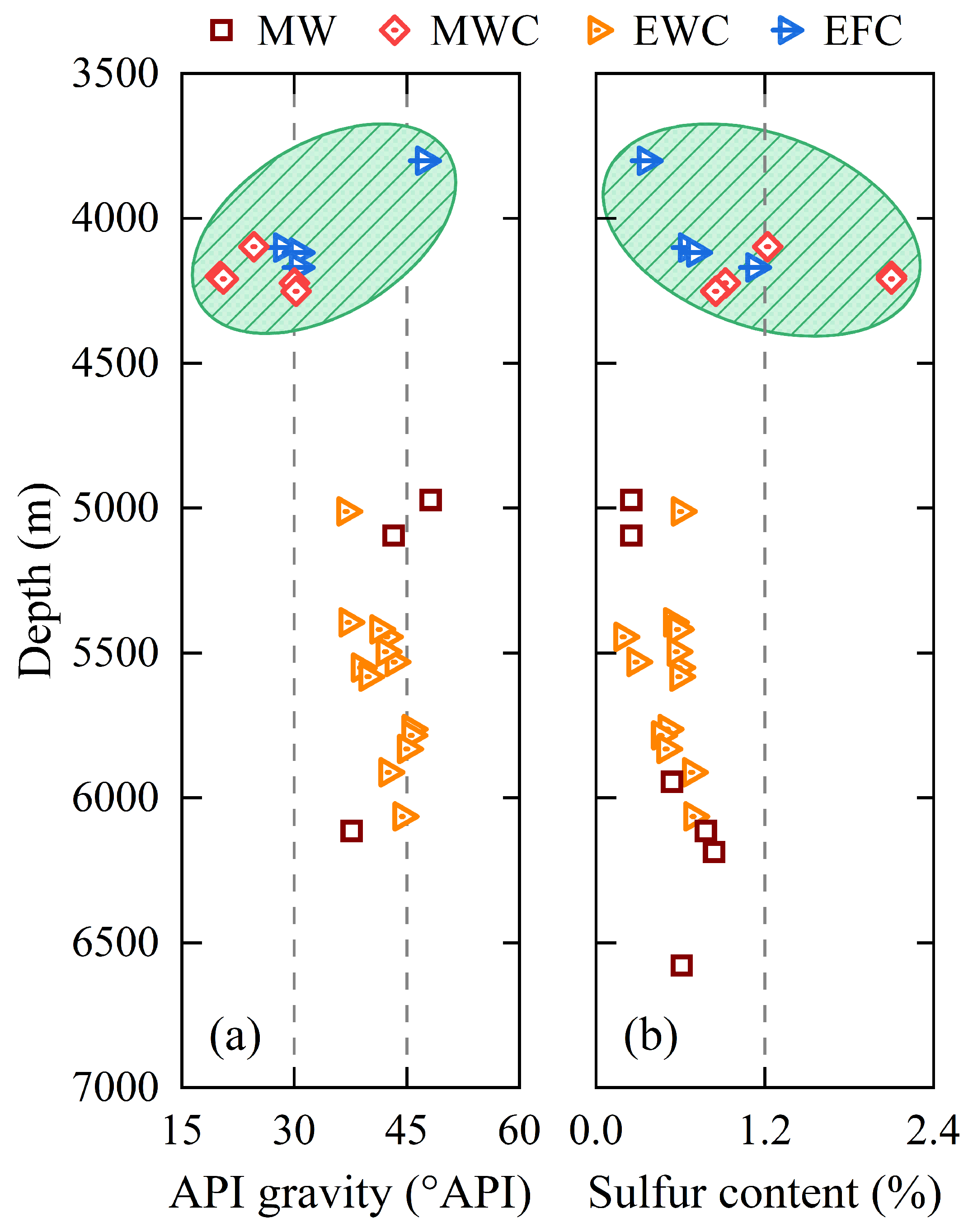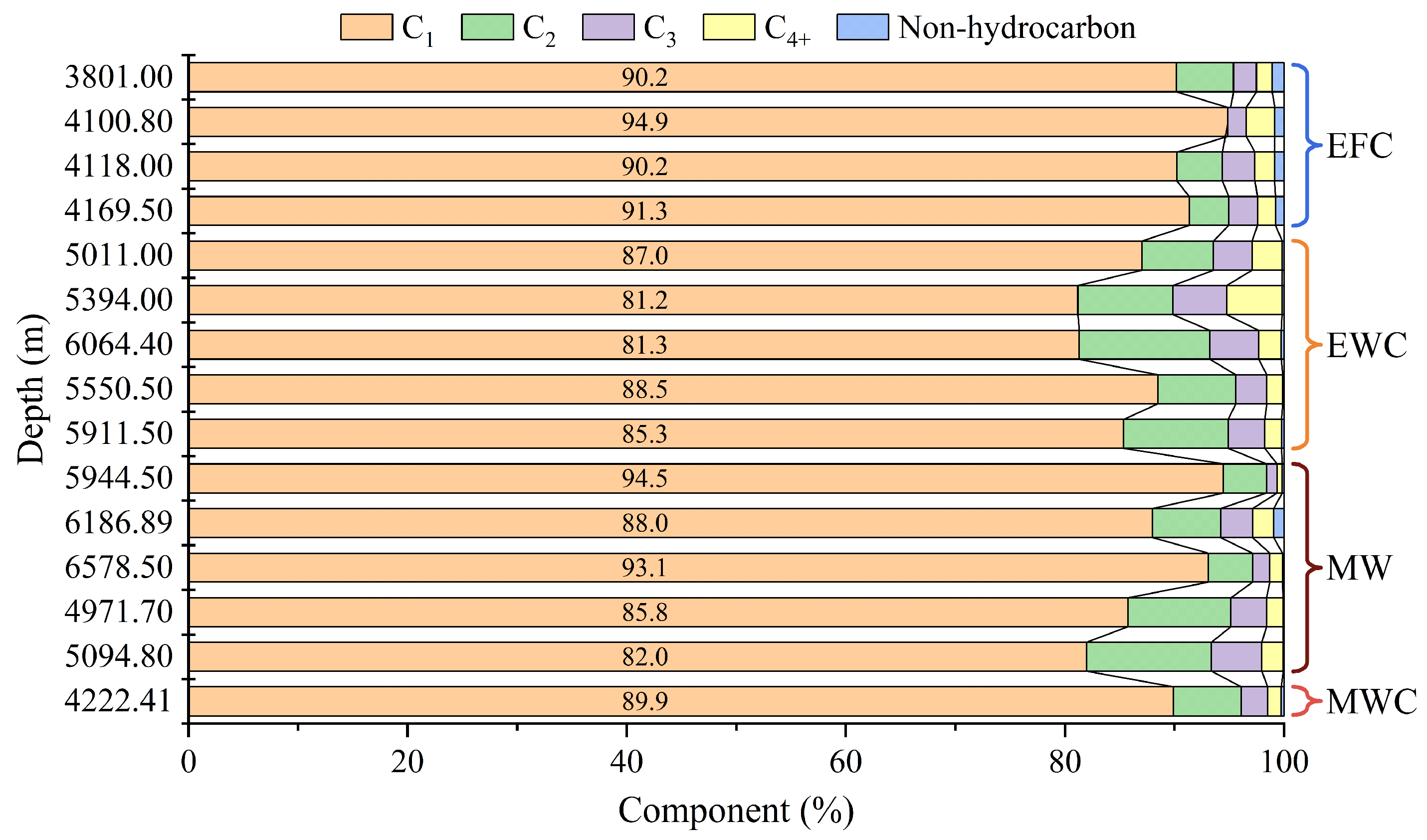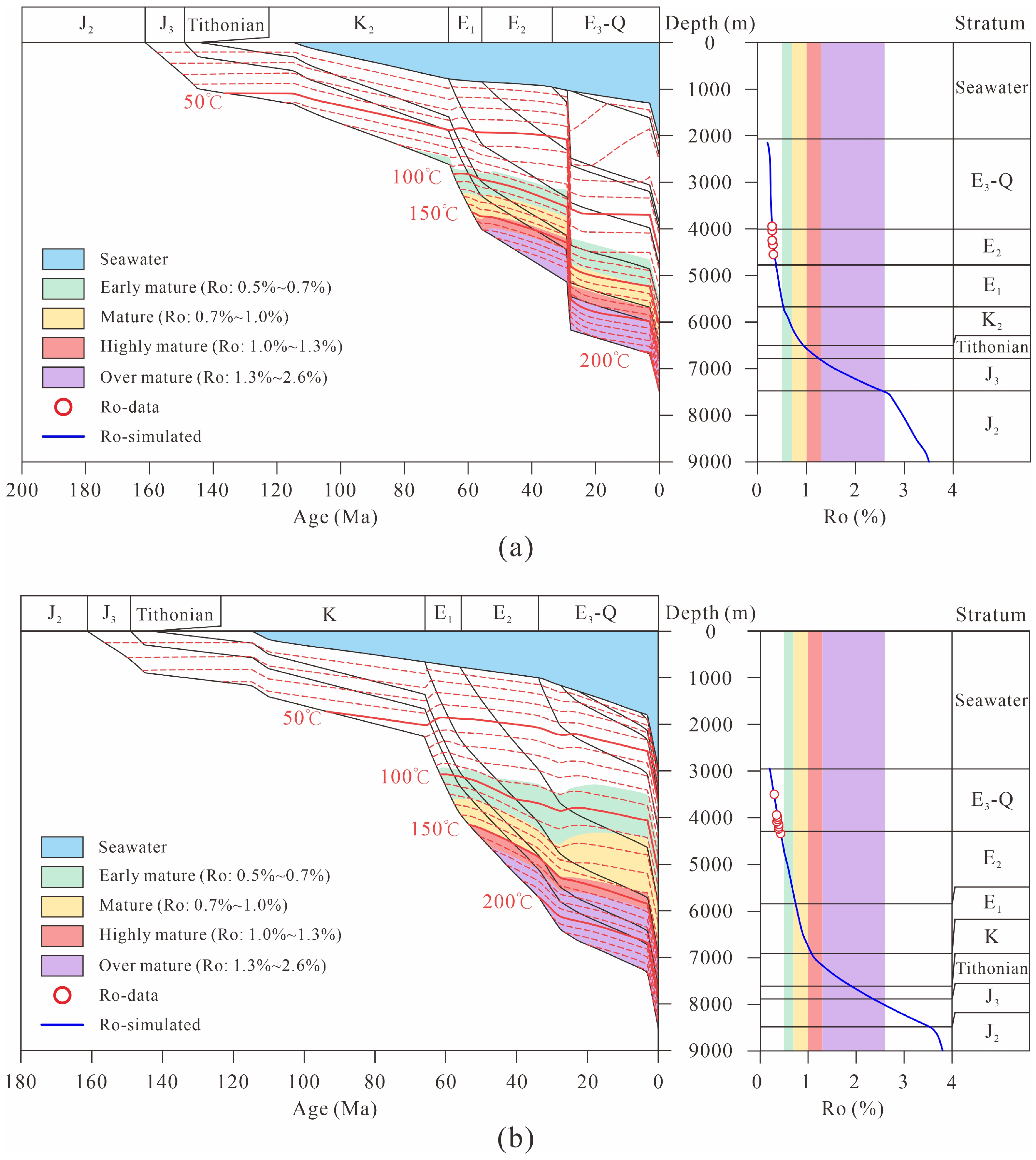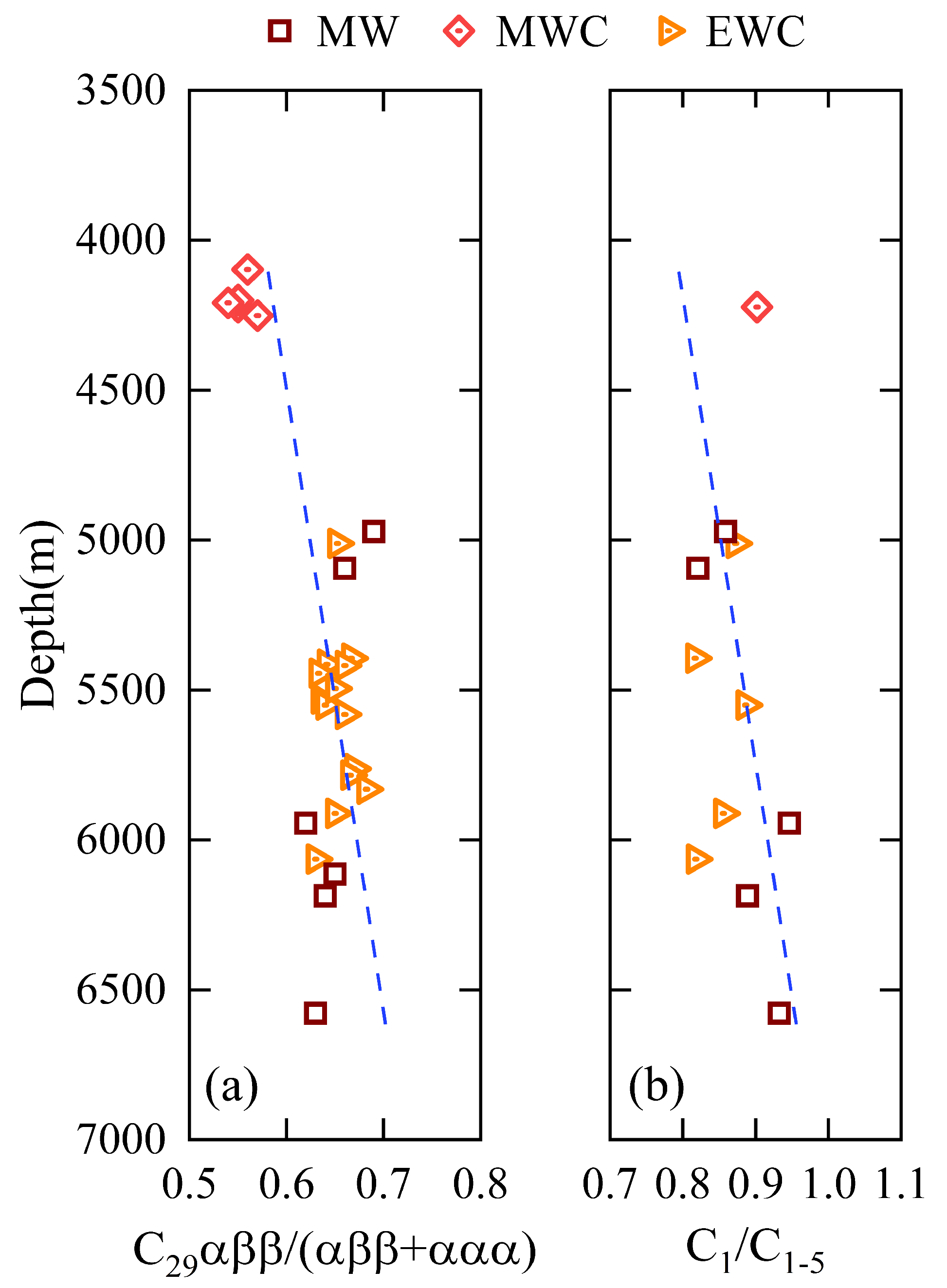Hydrocarbon Accumulation Characteristics of the Perdido Fold Belt, Burgos Basin, Gulf of Mexico—A Comparison Between the Central and Eastern Regions
Abstract
1. Introduction
2. Geological Background

3. Data and Methods
3.1. Data
3.2. Basin Modeling
3.3. Back-Stripping
4. Results
4.1. Geochemistry Characteristics of Hydrocarbon
4.1.1. Oil Geochemistry
4.1.2. Natural Gas Geochemistry
4.2. Origin and Generation of Hydrocarbon
5. Discussion
5.1. Transport Systems of Hydrocarbon
5.2. Migration Directions of Hydrocarbon
5.3. Accumulation Processes and Patterns of Hydrocarbon
- Type of oil and gas transport systems. The hydrocarbon migration pathway in the central region consists of reverse faults, negative inversion faults, and Wilcox Formation sandstone, while in the eastern region, it consists of source-rock-connected reverse faults, Wilcox Formation sandstone, thrust-fold faults, and Frio Formation sandstone.
- Threshold for gas generation of the source rocks. The source rocks in the central region entered the gas generation stage in the late Oligocene, while those in the eastern entered the gas generation window at the end of the Eocene.
- Hydrocarbon accumulation pattern. In the central region, hydrocarbons first migrate vertically from the source rocks to the Wilcox Formation along faults, then migrate to structurally high positions within the Wilcox Formation to form reservoirs, overall following a “step-like” single-layer accumulation pattern. In the eastern region, hydrocarbons migrate vertically from the source rocks to the Wilcox Formation and then to the Frio Formation along faults, forming “dome-shaped” gas reservoirs in the Wilcox Formation and “progradational” oil and gas reservoirs in the Frio Formation, overall exhibiting a dual-layer accumulation pattern.
5.4. Petroleum Systems
- Source rocks. The source rocks are marine carbonate rocks of the Jurassic Tithonian Stage, with large thickness, wide distributed area, abundant phytoplankton and bacteria-originated organic matters, Type I and Type II kerogen, and significant hydrocarbon generation potential.
- Reservoirs. The reservoir in the central region is the Wilcox Formation, while the reservoirs in the eastern region are the Wilcox Formation and the Frio Formation, both of which are marine turbidite sandstones.
- Caprocks. In the central region of the Perdido fold belt, the caprock was mudstone from the early Paleocene to the late Eocene, which has turned into allochthonous salt since the late Eocene. The caprock in the eastern region is always mudstone since the formation of the reservoirs. These caprocks are thickly and widely deposited in the study area, providing excellent preservation capacity for oil and gas reservoirs.
- Traps. The traps in the central region are anticline traps with a closing height of approximately 4 km, while in the eastern region, they are thrust-fold traps with a gentler structure and less closing height. Most of these traps were formed in the middle Eocene and finalized in the late Oligocene.
- Hydrocarbon generation. There are two major hydrocarbon generation periods in the central and eastern regions. Abundant oil was generated in the middle Eocene for the two regions, while the major generation period for natural gas was the late Oligocene and late Eocene in the central and eastern regions, respectively. The amount of oil and gas generated is only a qualitative display, which may be subject to uncertainty and does not represent an absolute quantity.
- Hydrocarbon charging. There were two stages of hydrocarbon charging events in both the central and eastern regions. The first stage of hydrocarbon charging occurred in the middle Eocene, with large amounts of crude oil charged into the Wilcox Formation. In the second stage, crude oil and gas charged into the Wilcox and Frio Formations, happening in the late Oligocene and late Eocene for the central and eastern regions, respectively.
- Reservoir preservation. The hydrocarbons in the central region have been protected by regional mudstone since the middle Eocene. But since the late Eocene, regional allochthonous salt rocks have served as caprocks. During the transformation period of the caprock, the reservoirs in the central region were destroyed. For the eastern region, the hydrocarbons have been continuously protected by regional mudstones since the middle Eocene to the present.
6. Conclusions
- The hydrocarbons in the central and eastern regions of the Perdido fold belt originate from the Tithonian source rocks, while their type and maturity are different. Mature medium–light crude oil is reserved in the Wilcox and Frio Formations, but the oil in the eastern region shows higher maturity. Gas in the central region is generated from type I and type II kerogen and is in the mature–highly mature stage. Gas in the eastern region is mainly cracked from type II kerogen and in the stage of low mature–mature.
- The Tithonian source rocks entered the oil generation stage in the late Paleogene and reached the oil generation peak in the middle Eocene, but entered the gas generation stage and peak in the late Oligocene and late Eocene, respectively. The natural gas generation in the central region of the Perdido fold belt was postponed since the development of super-thick allochthonous salt.
- The hydrocarbons mainly migrated from southwest to northeast and from deep buried strata to the shallow formations. Hydrocarbons in the central region first migrated vertically to the Wilcox Formation, and then migrated in the Wilcox Formation, presenting a “terraced single-layer” accumulation pattern. Hydrocarbons in the eastern region first migrated vertically to the Wilcox and Frio Formations, and then made westward-spreading adjustments in the Frio Formation, presenting a “double-layer” accumulation pattern.
- Differences exist in petroleum system elements between the central and eastern regions. By the systematic analyses and comparisons of the hydrocarbon accumulation in the central and eastern regions, it is believed that the eastern region is the preferable exploration zone.
Author Contributions
Funding
Data Availability Statement
Acknowledgments
Conflicts of Interest
Abbreviations
| API | American Petroleum Institute |
| BOE | Billion barrels of oil equivalent |
| C1 | Methane |
| C1/C1–5 | Dryness coefficient |
| C2 | Ethane |
| C3 | Propane |
| C4+ | Butane and heavier alkanes |
| C27 | C27 n-alkanes |
| C28 | C28 n-alkanes |
| C29 | C29 n-alkanes |
| C29ααα20S/(20S + 20R) | Sterane isomerization parameter |
| C29αββ/(ααα + αββ) | Sterane isomerization parameter |
| EFC | Cited data of the Frio Formation in the eastern region |
| EWC | Cited data of the Wilcox Formation in the eastern region |
| E1 | Paleocene |
| E2 | Eocene |
| E3 | Oligocene |
| HI | Hydrogen index (HI = S2/TOC) |
| J2 | Middle Jurassic |
| J3 | Late Jurassic |
| K | Cretaceous |
| K2 | Late Cretaceous |
| MWC | Cited data of the Wilcox Formation in the central region |
| MW | Data of the Wilcox Formation in the central region |
| N1 | Miocene |
| N2 | Pliocene |
| Q | Quaternary |
| Ro | Vitrinite reflectance |
| S2 | Pyrolysis hydrocarbon content |
| T3 | Upper Triassic |
| Tmax | Temperature of maximum pyrolysis yields |
| TOC | Total organic carbon |
| Ts/(Ts + Tm) | Relative content of trimethylhopane |
| 4/1-MDBT | Ratio of 4-methyldibenzothiophene to 1-methyldibenzothiophene |
| δ13C | Carbon isotopes |
References
- Bugti, M.N.; Mann, P. Regional source rock thermal stress modeling and map-based charge access modeling of the Port Isabel passive margin foldbelt, northwestern Gulf of Mexico. Interpretation 2023, 11, T717–T734. [Google Scholar] [CrossRef]
- Cunningham, R.; Snedden, J.W.; Norton, I.O.; Clement Olson, H.; Whiteaker, T.L.; Virdell, J.W. Upper Jurassic Tithonian-centered source mapping in the deepwater northern Gulf of Mexico. Interpretation 2016, 4, SC97–SC123. [Google Scholar] [CrossRef]
- Rowan, M.G. Structural architecture and evolution of eastern Mississippi Canyon, northern gulf of Mexico. Mar. Pet. Geol. 2023, 150, 106127. [Google Scholar] [CrossRef]
- Snedden, J.W.; Cunningham, R.C.; Virdell, J.W. The northern Gulf of Mexico offshore super basin: Reservoirs, source rocks, seals, traps, and successes. AAPG Bull. 2020, 104, 2603–2642. [Google Scholar] [CrossRef]
- Weimer, P.; Bouroullec, R.; Adson, J.; Cossey, S.P.J. An overview of the petroleum systems of the northern deep-water Gulf of Mexico. AAPG Bull. 2017, 101, 941–993. [Google Scholar] [CrossRef]
- Eikrem, V.; Li, R.; Medeiros, M.; McKee, B.J.; Boswell, B.L.; Shumilak, E.E.; Mohan, R. SS: Perdido Development Project: Great White WM12 Reservoir and Silvertip M. Frio Field Development Plans and Comparison of Recent Well Results with Pre-Drill Models. In Proceedings of the Offshore Technology Conference, Houston, TX, USA, 3–7 May 2010. [Google Scholar] [CrossRef]
- Davison, I.; Cunha, T.A. Allochthonous salt sheet growth: Thermal implications for source rock maturation in the deepwater Burgos Basin and Perdido Fold Belt, Mexico. Interpretation 2016, 5, T11–T21. [Google Scholar] [CrossRef]
- Wang, C.; Zeng, J.; Yu, Y.; Cai, W.; Li, D.; Yang, G.; Liu, Y.; Wang, Z. Origin, migration, and characterization of petroleum in the Perdido Fold Belt, Gulf of Mexico basin. J. Pet. Sci. Eng. 2020, 195, 107843. [Google Scholar] [CrossRef]
- Liu, Y.-M. Salt Evolution Mechanism and Hydrocarbon Accumulation in Santos Basin, Brazil. In Proceedings of the International Field Exploration and Development Conference 2021, Singapore, 8 September 2022; pp. 3527–3535. [Google Scholar] [CrossRef]
- Cai, J.; He, Y.; Liang, J.; Qiu, C.; Zhang, C. Differential deformation of gravity-driven deep-water fold-and-thrust belts along the passive continental margin of East Africa and their impact on petroleum migration and accumulation. Mar. Pet. Geol. 2020, 112, 104053. [Google Scholar] [CrossRef]
- Elfassi, Y.; Gvirtzman, Z.; Katz, O.; Aharonov, E. Chronology of post-Messinian faulting along the Levant continental margin and its implications for salt tectonics. Mar. Pet. Geol. 2019, 109, 574–588. [Google Scholar] [CrossRef]
- Zhang, Q.; Alves, T.M.; Martins-Ferreira, M.A.C. Fault analysis of a salt minibasin offshore Espirito Santo, SE Brazil: Implications for fluid flow, carbon and energy storage in regions dominated by salt tectonics. Mar. Pet. Geol. 2022, 143, 105805. [Google Scholar] [CrossRef]
- Bian, Q.; Deng, S.; Lin, H.; Han, J. Strike-Slip salt tectonics in the Shuntuoguole Low Uplift, Tarim Basin, and the significance to petroleum exploration. Mar. Pet. Geol. 2022, 139, 105600. [Google Scholar] [CrossRef]
- Zhu, Y.; Li, A.; Chen, L.; Lin, P. Distribution characteristics of deep/shallow bi-layered salt and the North-South differentialstructural deformation in the Perdido structural belt of Burgos basin, Mexico. China Offshore Oil Gas 2021, 33, 62–70. [Google Scholar] [CrossRef]
- Santamaria, D. Organic Geochemistry of Tithonian Source Rocks and Associated Oils from the Sonda de Campeche. Bachelor’s Thesis, RWTH Aachen University, Aachen, Germany, 2000. [Google Scholar]
- Li, A.; Cai, W.; Lu, J.; Yan, J.; Zhang, L.; Zhao, C. Analysis on petroleum conditions and exploration potential in Burgos Basin, north of Mexico. Mar. Geol. Front. 2020, 38, 77–85. [Google Scholar] [CrossRef]
- Salvador, A. Late Triassic-Jurassic Paleogeography and Origin of Gulf of Mexico Basin1. AAPG Bull. 1987, 71, 419–451. [Google Scholar] [CrossRef]
- Duffy, O.B.; Fernandez, N.; Peel, F.J.; Hudec, M.R.; Dooley, T.P.; Jackson, C.A.-L. Obstructed minibasins on a salt-detached slope: An example from above the Sigsbee canopy, northern Gulf of Mexico. Basin Res. 2020, 32, 505–524. [Google Scholar] [CrossRef]
- Eddy, D.R.; Van Avendonk, H.J.A.; Christeson, G.L.; Norton, I.O.; Karner, G.D.; Johnson, C.A.; Snedden, J.W. Deep crustal structure of the northeastern Gulf of Mexico: Implications for rift evolution and seafloor spreading. J. Geophys. Res. Solid Earth 2014, 119, 6802–6822. [Google Scholar] [CrossRef]
- Pindell, J.; Dewey, J. Permo-Triassic Reconstruction of Western Pangea and the Evolution of the Gulf of Mexico/caribbean Region. Tectonics 1982, 1, 179–211. [Google Scholar] [CrossRef]
- Marton, G.; Buffler, R.T. Jurassic Reconstruction of the Gulf of Mexico Basin. Int. Geol. Rev. 1994, 36, 545–586. [Google Scholar] [CrossRef]
- Worrall, D.M.; Snelson, S.; Bally, A.W.; Palmer, A.R. Evolution of the northern Gulf of Mexico, with emphasis on Cenozoic growth faulting and the role of salt. In The Geology of North America—An Overview; Geological Society of America: Boulder, CO, USA, 1989; Volume A. [Google Scholar] [CrossRef]
- Pindell, J.L.; Kennan, L. Tectonic evolution of the Gulf of Mexico, Caribbean and northern South America in the mantle reference frame: An update. In The Origin and Evolution of the Caribbean Plate; James, K.H., Lorente, M.A., Pindell, J.L., Eds.; Geological Society of London: London, UK, 2009; Volume 328. [Google Scholar] [CrossRef]
- Nguyen, L.C.; Mann, P. Gravity and magnetic constraints on the Jurassic opening of the oceanic Gulf of Mexico and the location and tectonic history of the Western Main transform fault along the eastern continental margin of Mexico. Interpretation 2016, 4, SC23–SC33. [Google Scholar] [CrossRef]
- Feng, J.; Buffler, R.T.; Kominz, M.A. Laramide orogenic influence on late Mesozoic-Cenozoic subsidence history, western deep Gulf of Mexico basin. Geology 1994, 22, 359–362. [Google Scholar] [CrossRef]
- Gray, G.; Pottorf, R.J.; Yurewicz, D.A.; Mahon, K.; Pevear, D.R.; Chuchla, R. Thermal and chronological record of syn- to post-Laramide burial and exhumation, Sierra Madre Oriental, Mexico. AAPG Mem. 2001, 75, 159–181. [Google Scholar] [CrossRef]
- Hudec, M.R.; Dooley, T.P.; Peel, F.J.; Soto, J.I. Controls on the evolution of passive-margin salt basins: Structure and evolution of the Salina del Bravo region, northeastern Mexico. GSA Bull. 2019, 132, 997–1012. [Google Scholar] [CrossRef]
- Snedden, J.W.; Tinker, L.D.; Virdell, J. Southern Gulf of Mexico Wilcox source to sink: Investigating and predicting Paleogene Wilcox reservoirs in eastern Mexico deep-water areas. AAPG Bull. 2018, 102, 2045–2074. [Google Scholar] [CrossRef]
- Winker, C.D.; Center, M.H.M. Cenozoic Shelf Margins, Northwestern Gulf of Mexico Basin. In Recognition of Shallow-Water Versus Deep-Water Sedimentary Facies in Growth-Structure Affected Formations of the Gulf Coast Basin; SEPM Society for Sedimentary Geology: Tulsa, OK, USA, 1981; Volume 2. [Google Scholar] [CrossRef]
- Galloway, W.E. Genetic Stratigraphic Sequences in Basin Analysis II: Application to Northwest Gulf of Mexico Cenozoic Basin1. AAPG Bull. 1989, 73, 143–154. [Google Scholar] [CrossRef]
- Waller, T.D. Structural Analysis of the Perdido Fold Belt: Timing, Evolution, and Structural Style. Master’s Thesis, Texas A&M University, College Station, TX, USA, 2007. [Google Scholar]
- Vazquez-Garcia, O. Tectonic Synthesis of the Deepwater Lamprea Thrust and Fold Belt, Offshore Burgos Basin, Western Gulf of Mexico. Master’s Thesis, Colorado School of Mines, Golden, CO, USA, 2018. [Google Scholar]
- Liang, J.; Huang, X.; Cai, W.; Wang, Y.; Chen, L.; Zhang, Y. Source-to sink system and exploration prospects of the Wilcox Formation in Perdido fold belt, Burgos Basin, Mexico. Acta Pet. Sin. 2019, 40, 1439–1450. [Google Scholar] [CrossRef]
- Yang, F.; Hu, W.; Cai, W.; Chen, Z. Characteristics and their forming mechanisms of the salt-mud diapiric structure in Perdido Structure Belt of Burgos Basin. Pet. Geol. Oilfield Dev. Daqing 2020, 39, 31–38. [Google Scholar] [CrossRef]
- Kong, G.; Li, A.; Zhu, Y.; Zhang, L.; Zhao, C.; Ding, P. Application of interpretation technology of salt-related trap in deepwater compression area offshore Burgos Basin, Mexico. Mar. Geol. Front. 2022, 38, 77–85. [Google Scholar] [CrossRef]
- Tang, Y.; Xue, K.; Gao, X.; Song, Y.; Li, H.; Wang, Y. Origin, maturity and geochemistry of natural gas in the Yancheng Sag, Subei Basin, China: Insights from pyrolysis experiments and basin modeling. J. Asian Earth Sci. 2025, 285, 106558. [Google Scholar] [CrossRef]
- Osman, M.; Farouk, S.; Salem, T.; Sarhan, M.A. Hydrocarbon generation potential of South Geisum Oilfield, Gulf of Suez, Egypt: Source rock evaluation and basin modeling for unconventional hydrocarbon prospects. Pet. Res. 2024, in press. [CrossRef]
- Du, S.; Hu, T. Mechanisms of hydrocarbon generation from organic matters: Theories, experiments and simulations. Adv. Geo-Energy Res. 2024, 12, 156–160. [Google Scholar] [CrossRef]
- Bishop, D.J.; Buchanan, P.G.; Bishop, C.J. Gravity-driven thin-skinned extension above Zechstein Group evaporites in the western central North Sea: An application of computer-aided section restoration techniques. Mar. Pet. Geol. 1995, 12, 115–135. [Google Scholar] [CrossRef]
- Peng, G.; Wu, Z.; Dai, Y.; Zhang, L.; Yu, S.; Wang, W.; Pang, H. Quantitative evaluation and models of hydrocarbon accumulation controlled by faults in the Pearl River Mouth Basin. Adv. Geo-Energy Res. 2023, 8, 89–99. [Google Scholar] [CrossRef]
- Demirbas, A.; Alidrisi, H.; Balubaid, M.A. API Gravity, Sulfur Content, and Desulfurization of Crude Oil. Pet. Sci. Technol. 2015, 33, 93–101. [Google Scholar] [CrossRef]
- Huang, W.-Y.; Meinschein, W.G. Sterols as ecological indicators. Geochim. Cosmochim. Acta 1979, 43, 739–745. [Google Scholar] [CrossRef]
- George, S.C.; Krieger, F.W.; Eadington, P.J.; Quezada, R.A.; Greenwood, P.F.; Eisenberg, L.I.; Hamilton, P.J.; Wilson, M.A. Geochemical comparison of oil-bearing fluid inclusions and produced oil from the Toro sandstone, Papua New Guinea. Org. Geochem. 1997, 26, 155–173. [Google Scholar] [CrossRef]
- Peters, K.E. Biomarkers and Isotopes in Petroleum Systems and Earth History; Cambridge University Press: Cambridge, UK, 2005. [Google Scholar]
- Galimov, E.M. Isotope organic geochemistry. Org. Geochem. 2006, 37, 1200–1262. [Google Scholar] [CrossRef]
- Quan, Y.; Liu, J.; Hao, F.; Bao, X.; Xu, S.; Teng, C.; Wang, Z. Geochemical characteristics and origins of natural gas in the Zhu III sub-basin, Pearl River Mouth Basin, China. Mar. Pet. Geol. 2019, 101, 117–131. [Google Scholar] [CrossRef]
- Clayton, C. Carbon isotope fractionation during natural gas generation from kerogen. Mar. Pet. Geol. 1991, 8, 232–240. [Google Scholar] [CrossRef]
- Stahl, W. Carbon isotope fractionations in natural gases. Nature 1974, 251, 134–135. [Google Scholar] [CrossRef]
- Whiticar, M. J. Carbon and hydrogen isotope systematics of bacterial formation and oxidation of methane. Chem. Geol. 1999, 161, 291–314. [Google Scholar] [CrossRef]
- Liu, C.; Chen, S.; Zhao, J.; Su, Z.; Chen, G.; Liu, X.; Gao, Q. Geochemical tracer of hydrocarbon migration path of Middle Cenozoic in the south slope of the Kuqa foreland basin. Acta Geol. Sin. 2020, 94, 3488–3502. [Google Scholar] [CrossRef]
- Zhao, J.; Zhang, W.; Li, J.; Cao, Q.; Fan, Y. Genesis of tight sand gas in the Ordos Basin, China. Org. Geochem. 2014, 74, 76–84. [Google Scholar] [CrossRef]
- Jinxing, D.; Shengfei, Q.; Shizhen, T.; GuangYou, Z.; Kuimi, J. Developing trends of natural gas industry and the significant progress on natural gas geological theorirs in China. Nat. Gas Geosci. 2005, 16, 127–142. [Google Scholar]
- Dai, J. Identification of different hydrocarbon gas. Sci. China Ser. B Chem. 1992, 2, 185–193. [Google Scholar]
- Langford, F.F.; Blanc-Valleron, M.-M. Interpreting Rock-Eval pyrolysis data using graphs of pyrolizable hydrocarbons vs. total organic carbon. AAPG Bull. 1990, 74, 799–804. [Google Scholar] [CrossRef]
- England, W.A.; Mackenzie, A.S.; Mann, D.M.; Quigley, T.M. The movement and entrapment of petroleum fluids in the subsurface. J. Geol. Soc. 1987, 144, 327–347. [Google Scholar] [CrossRef]
- Larter, S.R.; Bowler, B.F.J.; Li, M.; Chen, M.; Brincat, D.; Bennett, B.; Noke, K.; Donohoe, P.; Simmons, D.; Kohnen, M.; et al. Molecular indicators of secondary oil migration distances. Nature 1996, 383, 593–597. [Google Scholar] [CrossRef]
- Peters, K.E.; Fowler, M.G. Applications of petroleum geochemistry to exploration and reservoir management. Org. Geochem. 2002, 33, 5–36. [Google Scholar] [CrossRef]
- Li, Y.; Xiong, Y.; Liang, Q.; Fang, C.; Chen, Y.; Wang, X.; Liao, Z.; Peng, P.A. The application of diamondoid indices in the Tarim oils. AAPG Bull. 2018, 102, 267–291. [Google Scholar] [CrossRef]











| Data | Source | Subdivisions of the Perdido Fold Belt | |
|---|---|---|---|
| Central Region | Eastern Region | ||
| Three-dimensional seismic | This work | Yes | Yes |
| Stratigraphic division | This work | C-2 | M-2 |
| Geochemistry | This work | C-1, C-2, D-1, K-1, L-1, and H-1 | M-2 |
| Ref. [8] | T-1 and T-2 | E-1, M-1, M-3, N-1, and N-2 | |
Disclaimer/Publisher’s Note: The statements, opinions and data contained in all publications are solely those of the individual author(s) and contributor(s) and not of MDPI and/or the editor(s). MDPI and/or the editor(s) disclaim responsibility for any injury to people or property resulting from any ideas, methods, instructions or products referred to in the content. |
© 2025 by the authors. Licensee MDPI, Basel, Switzerland. This article is an open access article distributed under the terms and conditions of the Creative Commons Attribution (CC BY) license (https://creativecommons.org/licenses/by/4.0/).
Share and Cite
Fan, Y.; Xiang, C.; Yang, S.; Li, A.; Chen, L.; Pang, L.; Chen, J.; Yang, M. Hydrocarbon Accumulation Characteristics of the Perdido Fold Belt, Burgos Basin, Gulf of Mexico—A Comparison Between the Central and Eastern Regions. Energies 2025, 18, 1834. https://doi.org/10.3390/en18071834
Fan Y, Xiang C, Yang S, Li A, Chen L, Pang L, Chen J, Yang M. Hydrocarbon Accumulation Characteristics of the Perdido Fold Belt, Burgos Basin, Gulf of Mexico—A Comparison Between the Central and Eastern Regions. Energies. 2025; 18(7):1834. https://doi.org/10.3390/en18071834
Chicago/Turabian StyleFan, Yan, Caifu Xiang, Songling Yang, Aishan Li, Liang Chen, Lin’an Pang, Jingtan Chen, and Minghui Yang. 2025. "Hydrocarbon Accumulation Characteristics of the Perdido Fold Belt, Burgos Basin, Gulf of Mexico—A Comparison Between the Central and Eastern Regions" Energies 18, no. 7: 1834. https://doi.org/10.3390/en18071834
APA StyleFan, Y., Xiang, C., Yang, S., Li, A., Chen, L., Pang, L., Chen, J., & Yang, M. (2025). Hydrocarbon Accumulation Characteristics of the Perdido Fold Belt, Burgos Basin, Gulf of Mexico—A Comparison Between the Central and Eastern Regions. Energies, 18(7), 1834. https://doi.org/10.3390/en18071834





